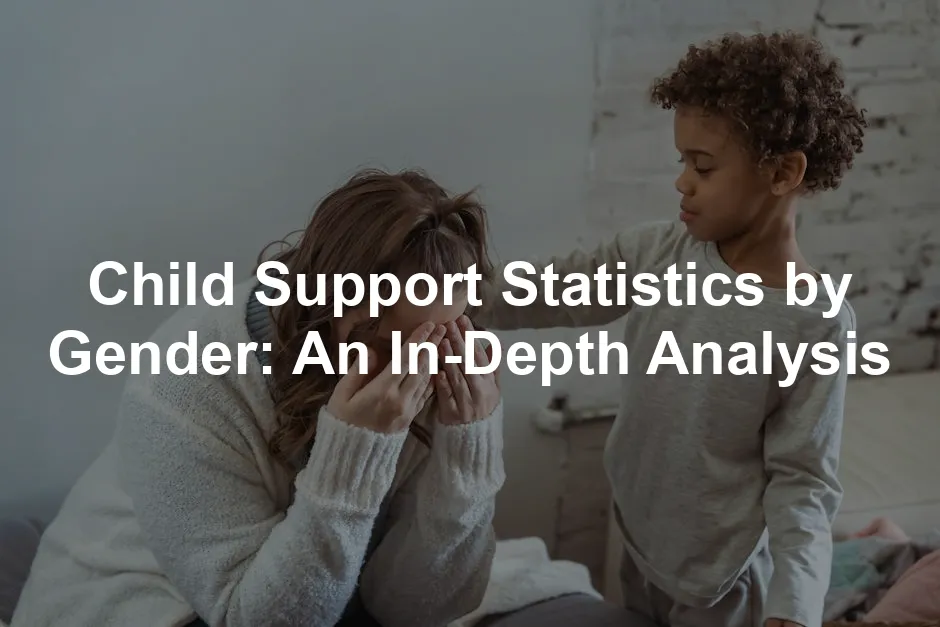Introduction
Child support is a crucial part of family law. It ensures that children receive the financial support they need after parents separate or divorce. This support helps cover essential expenses like food, clothing, education, and healthcare. Understanding child support is vital, especially when we look at statistics by gender. These numbers reveal disparities that can inform policy changes and improve the system.
By examining child support statistics through a gender lens, we can uncover important trends. For instance, the majority of custodial parents are mothers, which can lead to different experiences in securing support. Analyzing these statistics helps highlight the challenges faced by custodial and non-custodial parents. It also sheds light on the societal norms that shape our understanding of parental roles.
The objective of this article is clear: to analyze child support statistics by gender and discuss their implications. We will explore how these figures impact custodial and non-custodial parents, as well as the children caught in the middle. With a witty yet informative approach, we aim to provide valuable insights into this critical aspect of family law.

Understanding Child Support
What is Child Support?
Child support is a court-ordered payment from one parent to another. It typically occurs after divorce or separation. The legal basis for child support varies by state, but the core idea remains the same: both parents are responsible for financially supporting their children. The parent who spends less time with the kids usually pays support to the custodial parent, who lives with the children most of the time.
Determining the amount of child support involves several factors. States mainly use the income shares model, which calculates the support based on both parents’ incomes and the needs of the child. Some states might have different laws, but the goal is to ensure that the child maintains a similar standard of living as if the parents were together.
The Importance of Child Support
Child support plays a vital role in child welfare. It significantly impacts family economics, especially for single-parent households. Children in these families often face higher poverty rates. The U.S. Census Bureau highlights that single-mother families are more likely to live in poverty than single-father families. This financial strain can lead to various challenges, including reduced access to education and healthcare.
Statistics show that child support can alleviate some of this financial burden. For instance, a substantial percentage of custodial parents rely on these payments to cover basic needs. Child support not only helps families survive economically but also promotes children’s overall well-being. When children receive adequate support, they are more likely to thrive in their schooling, health, and emotional development.

Speaking of support, if you’re looking for a comprehensive resource, check out The Complete Guide to Child Support in America. This book offers insights into navigating the complexities of child support laws and provides practical tips for parents.
In summary, understanding child support is essential. It offers insight into the financial dynamics of single-parent households and helps us recognize the importance of equitable support systems for all parents.
Child Support Statistics Overview
National Statistics
Child support plays a vital role in ensuring children’s needs are met after parents separate. In 2021, a significant $20.2 billion was paid out in cash support across the United States. The average payment per custodial parent was approximately $441 a month. This indicates a hefty reliance on these payments for many families. As of the latest data, around 4.1 million parents received child support payments, showcasing a critical aspect of financial stability for many single-parent households.
The number of custodial parents is quite staggering; the U.S. Census Bureau reported about 12.9 million custodial parents in 2018. Among these, only about 43% received the full amount of support they were owed. Alarmingly, the percentage of custodial parents receiving any support at all is about 69%. This suggests that many custodial parents are left without the necessary financial assistance for their children’s upbringing.

Child Support Agreements
When it comes to child support agreements, the data reveals a split between formal and informal arrangements. Roughly 86% of custodial parents had either a legal or a verbal agreement with the non-custodial parent. However, nearly half of the custodial parents lack a legal child support agreement entirely. This lack of formalization can lead to complications in receiving payments. In 2018, only about 51% of custodial parents had a formal child support order in place.
Interestingly, among those without a legal agreement, nearly 39% believed that a formal order was unnecessary. Many felt that the other parent was contributing enough voluntarily. This perception, however, can lead to financial instability, as informal agreements are harder to enforce.
Child Support Payments by Gender
The statistics surrounding child support payments by gender tell a compelling story. Custodial mothers, who make up about 80% of custodial parents, are more likely to have legal agreements than fathers. In fact, 51% of custodial mothers had a legal order, compared to only 41% of custodial fathers. However, the percentage of custodial mothers receiving full payments stands at 46%, while custodial fathers fare slightly worse at 43%.
Speaking of understanding the numbers, if you want a deeper dive into child support calculations, consider using a Child Support Calculator. It can help you estimate payments based on your unique situation.
Custodial fathers are more likely to face challenges in receiving payments. A whopping 38% of custodial fathers reported never receiving any payment, while 29% of custodial mothers found themselves in the same boat. This disparity highlights the ongoing challenges that fathers face in securing the financial support that courts have deemed necessary for the well-being of their children.
While both genders contribute to child support, men are responsible for about 85% of payments made. Interestingly, the average annual payment from fathers is around $5,450, significantly higher than the $3,500 from mothers. This difference can lead to further financial strain on custodial mothers, who often rely heavily on these funds to provide for their children.
In summary, the landscape of child support in the U.S. is complex and often inequitable. The statistics reflect not only the financial obligations parents face but also the significant disparities between genders in both receiving and providing child support. Understanding these dynamics is crucial for informing policies that seek to create a more equitable system for all parents and, most importantly, for the children involved.

To gain deeper insights into child support statistics by gender, it’s essential to analyze how these disparities affect families.
Factors Influencing Gender Disparities
Child support doesn’t exist in a vacuum. Several societal and economic factors contribute to the gender disparities seen in child support payments. For starters, income differences play a significant role. Non-custodial fathers generally earn more than non-custodial mothers. This disparity often leads to fathers being ordered to pay significantly larger amounts in child support. The median annual payment from fathers hovers around $5,450, while mothers typically contribute only about $3,500.
Employment rates also affect these financial dynamics. Custodial mothers tend to work part-time more frequently than fathers. In fact, over 74% of custodial fathers are employed full-time year-round, compared to just 51% of custodial mothers. This reality can create a cycle, where custodial mothers struggling with lower incomes face challenges in securing the support they need.
Custody arrangements further complicate matters. Traditional gender roles often dictate that mothers become custodial parents, while fathers assume the non-custodial role. This situation can lead to assumptions about who should pay and how much. When courts determine custody, they may unintentionally reinforce these roles, influencing support obligations based on outdated stereotypes.

Case Studies
Real-life examples bring these statistics to life. Take the story of Tom, a custodial father who received a court order for child support from his ex-wife. Despite the order, he reported never receiving any payments. The court’s decision seemed straightforward, but reality painted a different picture. Tom struggled to provide for his children, facing financial strain without the support he was owed.
On the flip side, there’s Sarah, a custodial mother who, despite having a formal child support agreement, often received only partial payments. Her ex-husband would argue that his financial situation had changed, leading to inconsistent payments. Sarah’s case highlights how economic realities can impact court-ordered obligations, leaving her in a precarious position.
Anecdotal evidence suggests that gender biases may also influence court decisions. In many cases, judges might perceive fathers as less financially responsible, leading to leniency in payment obligations for non-custodial mothers. This bias can create a system where custodial fathers are less likely to receive the financial support they are entitled to, perpetuating the cycle of disparity.
These case studies illustrate the complexities of child support obligations and the challenges custodial parents face, highlighting the need for a more equitable approach in family law.
Financial and Emotional Impact of Child Support
The Economic Burden of Non-Payment
When child support payments vanish into thin air, custodial parents, especially mothers, face a mountain of challenges. Imagine relying on a financial lifeline that never comes. It can feel like trying to catch smoke with your bare hands. The impact is severe. According to the U.S. Census Bureau, a staggering 60% of custodial parents do not receive the full amount of child support owed to them, and nearly 29% of custodial mothers reported never receiving any payments at all.
This financial gap doesn’t just pinch; it often leads to outright poverty. Statistics reveal that 27% of custodial mothers live below the poverty line compared to just 11% of custodial fathers. This disparity highlights a harsh reality: mothers often shoulder the weight of financial responsibility without the necessary support. When child support payments are missed or inconsistent, it becomes a game of survival. Basic necessities like food, clothing, and medical care become luxuries that some single-parent families can’t afford.

The consequences extend beyond immediate financial distress. The lack of reliable income hampers the ability of custodial parents to maintain stable housing, secure quality childcare, or invest in their children’s education. It’s a vicious cycle that leaves families struggling to stay afloat, often forcing mothers to rely on public assistance programs, which can lead to feelings of inadequacy and helplessness.
Emotional and Psychological Effects
The emotional toll of inconsistent or non-receipt of child support is profound. For custodial parents, especially mothers, the stress can be overwhelming. Picture a parent juggling work, child-rearing, and the constant worry of making ends meet. Anxiety and depression can become unwelcome companions. Studies show that custodial parents who don’t receive child support are more likely to experience mental health issues. The strain of financial insecurity can lead to feelings of resentment and frustration.
Children, too, are not immune to the fallout. The instability of their home life can lead to behavioral and emotional problems. Children may feel the weight of their parents’ stress, leading to anxiety about their own futures. When financial support is lacking, it can also impact their self-esteem and overall well-being. Children in these circumstances may miss out on extracurricular activities or social events due to their family’s financial situation, further isolating them from their peers.
Moreover, the emotional effects can ripple through relationships. Tension often arises between custodial and non-custodial parents, making effective co-parenting challenging. This strain can hinder positive interactions, which are crucial for a child’s emotional development. The bottom line is clear: consistent child support is not just a financial issue; it’s a matter of emotional health and stability for the entire family.
Addressing these challenges requires a collective effort. Policymakers, community organizations, and families must work together to create systems that ensure child support is paid consistently and fairly. After all, every child deserves a stable and supportive environment to thrive.

Conclusion
In examining child support statistics by gender, the findings paint a telling picture. Custodial mothers dominate the landscape, comprising about 80% of custodial parents. Yet, they often face significant financial hurdles. While 46% of custodial mothers receive full child support payments, only 43% of custodial fathers see similar success. The stark reality is that many fathers struggle to secure payments. A staggering 38% of custodial fathers report never receiving any support, compared to 29% of custodial mothers.
These disparities raise pressing questions about the fairness of child support policies. As we’ve seen, traditional gender roles continue to impact who pays and who benefits from these payments. Moreover, societal perceptions about parenting responsibilities can influence court decisions, leading to biased outcomes that disadvantage custodial fathers.
This analysis underscores the urgent need for advocacy. We must push for more equitable child support policies that recognize the changing dynamics of modern families. Policymakers, legal professionals, and society must unite in addressing these disparities. It is essential to create a system that ensures fair treatment for all custodial and non-custodial parents, regardless of gender. Only then can we ensure that every child receives the financial support they need to thrive.
Let’s work together to advocate for change, ensuring that the child support system is not only fair but also effective. After all, a child’s well-being should never be a contentious issue.
FAQs
What percentage of custodial parents receive child support?
Statistics indicate that approximately 69% of custodial parents receive some form of child support. However, only about 43% receive the full amount they are owed. This gap highlights the challenges faced by many custodial parents in securing the necessary financial support for their children.
How is child support determined?
Child support amounts are calculated based on several factors, including parental income, the number of children, and the child’s needs. Courts typically use guidelines that consider both parents’ financial situations to ensure that children maintain a standard of living similar to what they would have enjoyed if the parents had remained together.
Are mothers less likely to pay child support than fathers?
Yes, statistics show that mothers are generally less likely to pay child support than fathers. About 85% of child support providers are men, and when women are ordered to pay, they tend to pay significantly lower amounts than their male counterparts. This trend reflects broader societal norms regarding gender roles in parenting.
How does child support differ by state?
Child support laws and practices can vary significantly by state. Each state has its own guidelines for calculating support, and these can be influenced by factors such as the cost of living, the incomes of both parents, and specific state legislation. As a result, some custodial parents may receive more support depending on their location.
What can non-custodial parents do if they can’t afford payments?
Non-custodial parents struggling to meet their child support obligations should consider seeking a modification of their support order. It’s crucial to document any changes in financial circumstances, such as job loss or reduced income. They can also reach out to legal professionals for guidance and explore resources that may provide assistance in managing their obligations.
Please let us know what you think about our content by leaving a comment down below!
Thank you for reading till here 🙂
All images from Pexels




